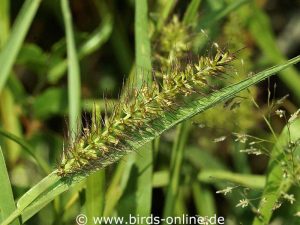- >>
- Birds Online – English
- >>
- Nutrition
- >>
- Healthy bird food from...
- >>
- Native grasses and cereals
- >>
- Rough bristle-grass (Setaria verticillata)
Rough bristle-grass
The rough bristle-grass (Setaria verticillata) is an annual plant species from the family of grasses (Poaceae). It can reach a height of 10 to 100 cm. Its stems are upright and the inflorescences are arranged in a panicle in the upper part of the stems. This is also where the seeds later form. This spike panicle has three to seven millimeter long bristles, which are equipped with backward-facing spiky hairs. They therefore cling to each other or other materials such as textiles like burdock. Because of this fact, the rough bristle-grass is also known as hooked bristlegrass. The rough bristle-grass can be confused with other bristlegrass species native to Germany. However, this is not a problem, as all bristlegrass species can be fed to pet birds.
Due to the long bristles, many small pet birds do not particularly like bristlegrass at first, as the bristles scratch their faces when they eat it. Larger parakeet and parrot species or species with broad beaks such as Barred parakeets, on the other hand, usually like rough bristlegrass when it is half ripe or ripe. The scratchy bristles have little effect on them. If you wish, you can also use nail scissors to shorten the bristles a little. Also keep in mind that the riper the grass, the stiffer and harder the bristles become.
Other English names of this plant species are hooked bristlegrass and bristly foxtail.
Several other species from the genus Setaria also grow in Central Europe, see related article.
More pictures of rushes can be found on NABU-naturgucker.de (German website, but also available in English language).
German – English translation: Sarah Wiechers

